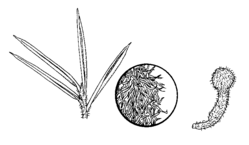Grevillea juniperina subsp. villosa Makinson APNI* 
Description: Robust erect shrub to 2 m high; branches arching to erect, columnar; foliage often in pseudo-whorls with leaves clustered.
Adult leaves dark green with paler veins, sublinear to narrowly elliptic, 11–21 mm long, (0.7-) 0.9–1.8 (-2.6) mm wide; upper surface convex, with midvein and intramarginal veins variably conspicuous; margins smoothly recurved to refracted; lower surface usually partially exposed, openly to sparsely subvillous, especially along midvein, or sometimes glabrous; juvenile leaves with margins scarcely recurved.
Flower colour: perianth and style red or yellow; style-end and pollen-presenter sometimes paler red or yellow, or green. Perianth tomentose to subvillous outside; limb of bud conspicuously shaggy-subvillous or tomentose. Pistil 18–25 mm long.
Flowering: Flowers mostly August–September, sporadically in other months.
Distribution and occurrence: Occurs in N.S.W. in the Southern Tablelands, known only from an area E and NE of Braidwood, and one old record from Currockbilly. Grows beside permanent watercourses in riparian shrub associations in remnant eucalypt forest, at altitudes of 550-600 m.
NSW subdivisions: ST
Text by R.O. Makinson
Taxon concept: R.O. Makinson (Fl. Australia)
APNI* Provides a link to the Australian Plant Name Index (hosted by the Australian National Botanic Gardens) for comprehensive bibliographic data
***The AVH map option provides a detailed interactive Australia wide distribution map drawn from collections held by all major Australian herbaria participating in the Australian Virtual Herbarium project.
|


